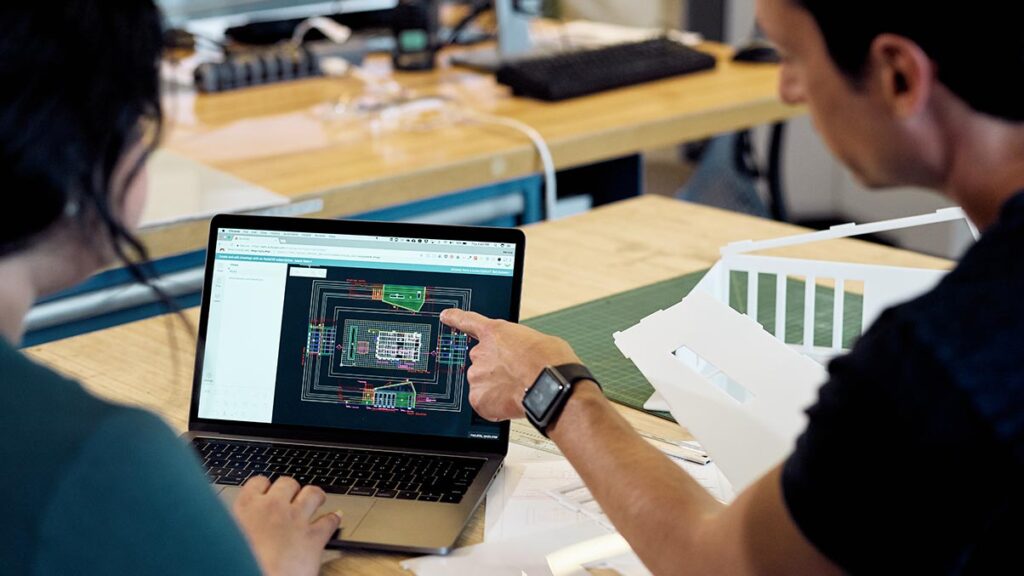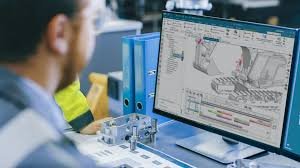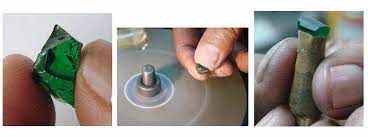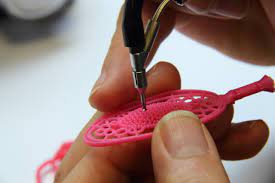Designer – CAD (6 Month Course)
SECTOR: GEMS & JEWELLERY
SUB-SECTOR:Cast and Diamonds-Set Jewellery
OCCUPATION: Designing and Product Development
REFERENCE ID: G&J/Q2303
ALIGNED TO: NCO-2004/ NIL
CAD Designer:

Using computer aided design (CAD), the CAD designer produces
drawings that serve as three-dimensional (3D) model for manufacturing
jewellery.
Brief Job Description:
The individual at work uses CAD software and tools to
produce a range of jewellery designs that are also practical for manufacturing.
CAD drawings provide all the information that forms the basis for every stage of
manufacturing the jewellery.
Personal Attributes: The job requires the individual to be capable of:
understanding design concepts and techniques; being creative; suggesting
design changes; giving attention to details. The individual must have good
eyesight; ability to present and explain designs; and be able to work in a process
driven team.
Create jewellery designs using CAD

G&J /N2303
Unit Title
(Task) Create jewellery design using CAD
Description This OS unit is about producing 3D CAD drawing which are practical; and providing
the detailing and dimensions for jewellery pieces to be manufactured
Scope This unit/task covers the following:
Receive the design concepts and instructions from different sources:
collect 2-dimensional (2D) or hand sketch designs from product development
head
assimilate design concepts from merchandiser or marketing department or
product development head
check design concepts from various jewellery design publications, exhibitions,
internet, websites of prominent jewellery companies, etc.
Create 3D jewellery designs using CAD software:
read 2D hand-sketch designs and blueprints in terms of size, dimensions,
shapes, materials
run CAD software for design
highlight different textures and surface enhancement techniques in the
jewellery design, e.g., mill graining
prepare designs considering cut and shape of diamond/stone
create a 3DCAD graphic showing rendering views of the object from different
positions, which gives impression of virtual jewellery piece
provide detailed information related to: the item to be made, overall
dimensions, notes on material choice (e.g., gold weight), diamonds and/or
gemstones to be used (e.g., numbers, sizes, types), and proposed manufacturing
specifications
Return prepared CAD designs to merchandiser and/or product development head:
self-check each design in terms of dimensions, clarity and practicality
make timely delivery of the required number of approved designs
Data management:
store or save files and folders
transfer design data to cam system operator after approval from merchandiser
and/or product development head
Report problems related to:
complexity of designs
problems with faulty equipment or software operation and report them to the
appropriate person
errors on any CAD designs made, and take appropriate action if errors are found
reasons for anticipated delays that may adversely affect delivery
Interact with superior to:
receive instructions and feedback from merchandiser and/or product
Create jewellery designs using CAD

Performance Criteria(PC) w.r.t. the Scope
Element Performance Criteria
Using CAD tools to
produce a range of 3D
jewellery designs
To be competent, the user/individual on the job must be able to:
1. select appropriate software tools
2. make effective use of images, diagrams, repeat patterns, signs, symbols,
etc.
3. accurately delineate the design developments showing cut and shape of
diamond or gemstones
4. accurately highlight with specific colours, showing isometric projection,
orthographic projection, scaling, dimensioning (e.g., prong thickness, prong
height, gap between prongs and gap between diamonds, making seat and
hole for the diamond etc.)
5. make notes relating to materials and production (e.g., shrinkage
parameter)
6. accurately create different views of the object in different positions
7. give clear views for all the different positions from different angles
8. provide accurate and complete information related to design in terms of
overall dimensions, material choice, diamond and stones and proposed
manufacturing specifications
Productivity To be competent, the user/individual on the job must be able to:
9. make timely delivery of CAD jewellery designs to Computer Aided Machine
(CAM) operator
10. produce the number of CAD designs as per target given
11. produce defect-free output with minimal setbacks
Quality of output To be competent, the user/individual on the job must be able to:
12. maintain practicality and look of the design as per the design concept
13. produce well balanced designs based on inputs from marketing, product
development and production department
Knowledge and Understanding (K)
A. Organizational
Context
The user/individual on the job needs to know and understand:
1. company’s policies on: quality, incentives, delivery standards, safety and
hazards, integrity and IPR, and personnel management
2. importance of the individual’s role in the workflow
3. reporting structure
B. Technical
Knowledge
The user/individual on the job needs to know and understand:
1. how to use computers, CAD workstation software and hardware, compact
digital camera, MSOffice, data management software, internet, etc.
2. the tools and commands used for CAD
3. remain well-informed about latest software and designing tools useful for
jewellery designing
Create jewellery designs using CAD

KB4. different textures, mill graining and cut-outs in the jewellery design
KB5. different types of jewellery products rings, bracelets, pendants, necklace
KB6. different types of diamonds and/or gemstones, colours, cuts, shapes and
settings
KB7. manufacturing drawing practices as per the company standards
KB8. design techniques, tools, principals involved in production of precision
designs, blueprints, drawings, and models
Skills (S) [Optional]
A. Core Skills/ Generic
Skills
Basic reading and writing skills
The user/ individual on the job needs to know and understand how to:
SA1. read notes, designs and instructions in terms of design concepts
SA2. read company rules and compliance documents required to complete the
work
SA3. read design and software related books
Calculation and Geometry skills
The user/individual on the job needs to know and understand how to:
SA4. count the number of diamonds and/or gemstones and assess the weight of
precious metal and other materials required for the design to be
converted into jewellery
SA5. assess accuracy of dimensions and symmetry
SA6. use basic calculations in design
Teamwork
The user/individual on the job needs to know and understand how to:
SA7. deliver the designs to next work process on time
B. Professional Skills Creative thinking
The user/individual on the job needs to know and understand:
SB1. how to visualise designs
SB2. how to translate design ideas or concepts to 3d designs
Computer and Software skills
The user/individual on the job needs to know and understand how to:
SB3. operate computer, scanner, etc.
SB4. work on cad software
SB5. manage and secure data
Measuring and Calibrating skills
The user/individual on the job needs to know and understand how:
SB6. to use the measuring tools such as vernier callipers, scale, etc.
Reflective thinking
The user/individual on the job needs to know and understand how to:
SB7. produce successful CAD designs
SB8. improve work processes for greater productivity
Create jewellery designs using CAD

SB9. pre-empt design related issues in the production and reporting it to
merchandiser and/or production development head
Critical thinking
The user/individual on the job needs to know and understand how to:
SB10. make necessary design changes for practicality and maintain aesthetics of
the jewellery design
Create jewellery designs using CAD
NOS Version Control
NOS Code G&J/N2303
Credits(NVEQF/NVQF/NSQF) TBD Version number 1.0
Industry Gems &Jewellery Drafted on 29/05/13
Industry Sub-sector
Cast and Diamond-set
Jewellery Last reviewed on 11/07/13
Occupation Designing and product
development Next review date 15/06/15
Respect and maintain IPR
G&J/N9901
Unit Title
(Task) Maintain IPR of company and respect IPR of other companies
Description This OS unit is about protecting company’s IPR and avoiding infringement to IPR of
other companies
Scope This unit/task covers the following:
Protect company’s Intellectual Property Rights (IPR)
prevent leak of new designs to competitors by reporting on time
be aware of any of company’s product or design patents
report IPR violations observed in the market, to supervisor or company heads
Avoid infringement to IPR of other companies
read copyright clause of the material published on the internet and any other
printed material
consult supervisor or senior management when in doubt about using publicly
available information
report any infringement observed in the company
Performance Criteria(PC) w.r.t. the Scope
Element Performance Criteria
Respecting and
Maintaining IPR
To be competent, the user/individual on the job must:
PC1. be able to spot plagiarism and report
PC2. be aware of patents and IPR
PC3. not be involved in IPR violations
Knowledge and Understanding (K)
C. Organizational
Context
The user/individual on the job needs to know and understand:
KA1. company’s policies on IPR and plagiarism
KA2. reporting structure
KA3. company’s unique product range
B. Technical
Knowledge
The user/individual on the job needs to know and understand:
KB1. patents and IPR laws
KB2. how IPR protection is important for competitiveness of a company
Skills (S) [Optional]
C. Core Skills/
Generic Skills
Communication skills
The user/ individual on the job needs to know and understand how to:
SA1. effectively communicate any observed IPR violations or order leaks
D. Professional Skills Decision making
The user/individual on the job needs to know and understand how to:
SA2. report potential sources of violations
Respect and maintain IPR
Reflective thinking
The user/individual on the job needs to know and understand to:
SA3. learn from past mistakes and report IPR violations on time
Critical thinking
The user/individual on the job needs to know and understand how to:
SA4. spot signs of violations and alert authorities in time
Coordinate with others
Unit Code G&J/N9902
Unit Title
(Task) Interact with colleagues and seniors
Description This OS unit is about communicating with colleagues and seniors in order to achieve
smooth and hazard-free work flow
Scope This unit/task covers the following:
Interact with supervisor
receive work instructions and raw materials from reporting supervisor
communicate to reporting supervisor about process-flow improvements, product
defects received from previous process, repairs and maintenance of tools and
machinery as required
communicate any potential hazards or expected process disruptions
handover completed work to supervisor
Interact with colleagues within and outside the department
work as a team with colleagues and share work as per their or own work load and
skills
work with colleagues of other departments
communicate and discuss work flow related difficulties in order to find solutions
with mutual agreement
receive feedback from qc and rework in order to complete work on time
Performance Criteria(PC) w.r.t. the Scope
Element Performance Criteria
Interaction with
supervisor
To be competent, the user/individual on the job must be able to:
PC1. understand the work output requirements
PC2. comply with company policy and rule
PC3. deliver quality work on time as required by reporting any anticipated reasons
for delays
Interactions with
colleagues and other
departments
To be competent, the user/individual on the job must be able to:
PC4. put team over individual goals
PC5. be able to resolve conflicts
PC6. learn how to multi-task relevant activities
Knowledge and Understanding (K)
A. Organizational
Context
The user/individual on the job needs to know and understand:
KA1. company’s policies on: preferred language of communication, reporting and
escalation policy, quality delivery standards, and personnel management
KA2. reporting structure
B. Technical
Knowledge
The user/individual on the job needs to know and understand how to:
KB1. communicate effectively
KB2. build team coordination
Coordinate with others
Skills (S) [Optional]
A. Core Skills/
Generic Skills
Communication skills
The individual on the job needs to know and understand how to:
SA1. read and write preferred language of communication as prescribed by the
company
SA2. read job sheets and interpret technical details mentioned in the job sheet
B. Professional Skills Decision making
The individual on the job needs to know and understand:
SB1. how to spot and communicate potential areas of disruptions to work process
and report the same
SB2. when to report to supervisor and when to deal with a colleague individually,
depending on the type of concern
Reflective thinking
The individual on the job needs to know and understand how to:
SB3. improve work processes by interacting with others and adopting best
practices
Critical thinking
The individual on the job needs know and understand how to:
SB4. spot process disruptions and delays and report and communicate with
solutions
Maintain occupational health and safety
G&J/N9905
Unit Title
(Task) Maintain occupational health and safety
Description This OS unit is about being aware of, communicating and taking steps towards
minimizing potential hazards and dangers of accidents on the job and maintaining
occupational health and safety
Scope This unit/task covers the following:
Understand potential sources of accidents
to avoid accidents related to use of potentially dangerous chemicals, sharp tools
and machines
Use safety gear to avoid accidents
wear safety gear such as goggles, mask, gloves, ear plugs
Actively participate in the health and safety awareness campaigns
attend fire drills organised by the company or industrial zone
learn first aid procedure
be alert about designated assembly area in the event of an emergency
read and understand the evacuation and emergency procedures
Communicate to reporting supervisor about:
process flow improvements that can reduce anticipated or repetitive hazards
mishandling of tools, machines or hazardous materials
electrical problems that could result in accident
Performance Criteria(PC) w.r.t. the Scope
Element Performance Criteria
Communicating
potential accident
points
To be competent, the user/individual on the job must be able to:
PC1. spot and report potential hazards on time
PC2. follow company policy and rules regarding use of hazardous materials
PC3. attend and actively participate in the health and safety campaigns organised
by the company
Using safety gear To be competent, the user/individual on the job must be able to:
PC4. use or wear safety gear as per the rules of the company
Knowledge and Understanding (K)
A. Organizational
Context
The user/individual on the job needs to know and understand:
KA1. company’s policies on: safety and hazards and personnel management
KA2. reporting structure
B. Technical
Knowledge
The user/individual on the job needs to know and understand:
KB1. how different chemicals react and what could be the danger from them
KB2. how to use machines and tools without suffering bodily harm
Maintain occupational health and safety
Communication skills
The individual on the job needs to know and understand how to:
SA1. effectively communicate the danger
Organising skills
The individual on the job needs to know and understand how to:
SA2. keep all the tools in an organised manner so as to avoid accidents
SA3. keep the work environment safe and clean
B. Professional Skills Decision making
The individual on the job needs to know and understand how to:
SB1. report potential sources of danger
SB2. follow prescribed procedure in the event of an accident
SB3. wear appropriate safety gear to avoid an accident
Reflective thinking
The individual on the job needs to know and understand to:
SB4. learn from past mistakes regarding use of hazardous machines or chemicals
Critical thinking
The individual on the job needs to know and understand how to:
SB5. spot danger
Decision making
The individual on the job needs to know and understand how to:
SB6. report potential sources of danger
SB7. follow prescribed procedure in the event of an accident
SB8. wear appropriate safety gear to avoid an accident
Maintain occupational health and safety
NOS Version Control
NOS Code G&J/N9905
Credits(NVEQF/NVQF/NSQF) TBD Version number 1.0
Industry Gems &Jewellery Drafted on 29/05/13
Industry Sub-sector
Cast and diamond-set
jewellery Last reviewed on 11/07/13
Next review date 15/06/15
Keywords /Terms Description
Sector Sector is a conglomeration of different business operations having similar
business and interests. It may also be defined as a distinct subset of the
economy whose components share similar characteristics and interests.
Sub-sector Sub-sector is derived from a further breakdown based on the
characteristics and interests of its components.
Occupation Occupation is a set of job roles, which perform similar/ related set of
functions in an industry.
Function Function is an activity necessary for achieving the key purpose of the
sector, occupation, or an area of work, which can be carried out by a
person or a group of persons. Functions are identified through functional
analysis and form the basis of OS.
Sub-function Sub-functions are sub-activities essential to fulfil the achieving the
objectives of the function.
Job role Job role defines a unique set of functions that together form a unique
employment opportunity in an organisation.
Occupational Standards
(OS)
OS specify the standards of performance an individual must achieve
when carrying out a function in the workplace, together with the
knowledge and understanding they need to meet that standard
consistently. Occupational Standards are applicable both in the Indian
and global contexts.
Performance Criteria Performance criteria are statements that together specify the standard of
performance required when carrying out a task.
National Occupational
Standards (OS)
NOS are occupational standards which apply uniquely in the Indian
context.
Qualifications Pack (QP) QP comprises the set of OS, together with the educational, training and
other criteria required to perform a job role. A QP is assigned a unique
qualifications pack code.
Unit Code Unit code is a unique identifier for an Occupational Standard, which is
denoted by an ‘N’
Unit Title Unit title gives a clear overall statement about what the incumbent
should be able to do.
Description Description gives a short summary of the unit content. This would be
helpful to anyone searching on a database to verify that this is the
appropriate OS they are looking for.
Scope Scope is a set of statements specifying the range of variables that an
individual may have to deal with in carrying out the function which have
a critical impact on quality of performance required.
Knowledge and
Understanding
Knowledge and understanding are statements which together specify the
technical, generic, professional and organisational specific knowledge
that an individual needs in order to perform to the required standard.
Organisational Context Organisational context includes the way the organisation is structured
and how it operates, including the extent of operative knowledge
managers have of their relevant areas of responsibility.
Technical Knowledge Technical knowledge is the specific knowledge needed to accomplish
specific designated responsibilities.
Core Skills/ Generic
Skills
Core skills or generic skills are a group of skills that are the key to learning
and working in today’s world. These skills are typically needed in any
work environment in today’s world. These skills are typically needed in
any work environment. In the context of the OS, these include
communication related skills that are applicable to most job roles.
Keywords /Terms Description
CAD Computer Aided Design
CAM Computer Aided Manufacturing
IPR Intellectual Property Rights
NOS National Occupational Standard(s)
NVQF National Vocational Qualifications Framework
NSQF National Qualifications Framework
NVEQF National Vocational Education Qualifications Framework
QP Qualifications Pack
Sub-sector Range of Occupation numbers
Handmade gold and gems-set jewellery 01-20
Cast and diamond-set jewellery 21-40
Diamond processing 41-60
Gemstone processing 61-80
Jewellery retailing 81-98
Sequence Description Example
Three letters Industry name G&J
Slash / /
Next letter Whether QP or NOS N
Next two numbers Occupation code 01
Next two numbers OS number 01
CRITERIA FOR ASSESSMENT OF TRAINEES
Job Role: CAD Designer
Qualification Pack G&J/Q2303
Sector Skill Council Gem & Jewellery
Guidelines for Assessment
- Criteria for assessment for each Qualification Pack will be created by the Sector Skill Council. Each
Performance Criteria (PC) will be assigned marks proportional to its importance in NOS. SSC will also lay
down proportion of marks for Theory and Skills Practical for each PC. - The assessment for the theory part will be based on knowledge bank of questions created by the SSC.
- Individual assessment agencies will create theory question papers for candidates at every
examination/training centre. (as per assessment criteria below) - Individual assessment agencies will create practical tests for skill evaluation for candidates at every
examination/training centre. (as per assessment criteria below) - To pass the Qualification Pack, every candidate should score a minimum of 50% in theory and 70% in
practical to successfully clear the assessment. - In case of successfully passing only certain number of NOS’s, the candidate is eligible to take subsequent
assessment on the balance NOS’s to pass the Qualification Pack.
PC13. produce well
balanced designs
based on inputs from
marketing, product
development and
production
department
5 0 5
Total 75 10 65
- G&J/N9901 Respect
and maintain IPR
PC1. be able to spot
plagiarism and report
9
3 2 1
PC2. be aware of
patents and IPR 4 1 3
PC3. not be involved in
IPR violations 2 1 1
Total 9 4 5 - G&J/N9902
Coordinate with other
PC1. understand the
work output
requirements
8
2 1 1
PC2. comply with
company policy and
rule
1 0 1
PC3. deliver quality
work on time as
required by reporting
any anticipated
reasons for delays
1 0 1
PC4. put team over
individual goals 1 1 0
PC5. be able to resolve
conflicts 1 0 1
PC6. learn how to
multi-task relevant
activities
2 1 1
Total 8 3 5 - G&J/N9905
Maintain occupational
health and safety
PC1. spot and report
potential hazards on
time
8
2 1 1
PC2. follow company
policy and rules
regarding use of
hazardous materials
2 0 2
PC3. attend and
actively participate in
the health and safety
campaigns organised
by the company
2 1 1
PC4. use or wear
safety gear as per the
rules of the company
2 1 1
Total 8 3 5








